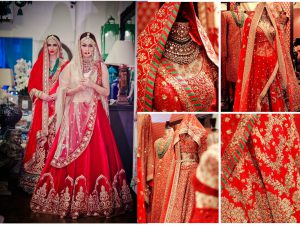Relax Ladies, It’s Only A Lehenga

This is as good a time as any to talk about ‘phashion’. Frankly, it’s reached a stage when I cannot tell one designer from the other. Not that it matters. I am not their target client. Every other week is fashion week in India. With the same bunch of 200 people in attendance applauding the same bunch of 20 designers.
I often pity fashion writers, bloggers and commentators who are compelled to scratch their heads and come up with something different to say about the same old shows, featuring the same old faces and the same old clothes. Well, pretty much the same. Switch the eternal pink lotus motif with pink flamingos and everybody goes “Oooooh!” Like a new fashion revolution has just started. In reality, nothing much has changed for the past 35 years. Except the price tags.
Now that pink flamingos are dancing all over the place and the old Chinese and Japanese-inspired cranes have taken flight and gone back, let’s count the many clones on the ramp. Capes are done, done, done…. but they haven’t marched off the catwalk yet. Drapes are well, drapes. Every second fashionista resembles a curtains ki dukaan, with yards and yards of fabric cascading over gymmed out scrawny collarbones. The wretched ‘gowns’ are still around, brazen rip-offs from famous Western designers’ past collections. Fashion police are quick to point out the theft, but that hardly bothers the thick-of-skin and short-on-originality types.
Then come the OTT, blingy bridal lehengas. Uffff… poor brides. These nervous creatures are terrorised into spending lakhs and lakhs on outfits that only underwrite a designer’s vanity and ego. Can you really tell one lehenga from another? I went to a gigantic warehouse in Amritsar recently. The proud owner, a well-meaning lady, innocently told her sales staff to show me “Anushka Sharma’s wedding lehenga”. Huh! Four hefty, hirsute men brought out a large package from the innards of the store. Madamji instructed the slimmest chap to wear it and twirl. Clearly, it wasn’t his first time. He deftly climbed into it, draped the dupatta over his head and voila — instant Anushka happened. Madamji beamed with pride. “We have already sold six pieces,” she stated, adding, “Same-to-same copy hai ji, nobody can tell the difference.” True.
And here’s another delicious story. This time from Gujarat. A lovely and wealthy young lady had just returned from a plush wedding in Bombay. And she was feeling very, very low. Confessed she in a forlorn little voice, “I had taken my best outfits and jewellery, my latest handbags and shoes… even then, most of the other Bombay women made me feel very yesterday and out of style. Bombay wedding are in a different league — my head was spinning just staring at this one and that one. What fashion, what accessories!” Really? Given Gujarat’s incredibly rich textile traditions, why wouldn’t this attractive, confident and well-travelled professional trust her own instincts and wear a one-of-akind, exquisite hand-woven Patola, for example? With her grandmother’s handcrafted jewellery?
She looked genuinely puzzled. “But, I don’t want to look like an aunty.” It is precisely this insecurity that designers exploit. They make young, bewildered brides and their clueless mothers feel inadequate and ‘uncool’ as soon as they enter the fancy salon, with heady khus fragrance enveloping the senses and lulling one into a state of utter vulnerability. During that moment of weakness, a client is ready to buy anything, even that absurdly priced donkey brown lehenga, designed by an obnoxiously arrogant ‘couturier’.
That’s really how the rarefied world of fashion operates. Not just here in India, but across the world. On a recent trip to Munich, I watched well-heeled Chinese buyers cowering in Chanel couture while waiting for the Louis Vuitton store to open. Locals mentioned how sales staff in all the high-end stores dreaded the onslaught of Chinese clients during the summer months. They loved the scads of money spent by the ladies from Shanghai and Beijing, but had zero respect for their taste. “They will buy anything we recommend.” That’s true about India as well. Most of our designers wait to pounce on insecure moneybags and sell them their priciest garments. The art of the deal is to pretend that you are doing the buyer a favour by parting with that ghastly multi-lakh tag wala lehenga.
Now that every major city in India has its own version of the Delhi/Bombay fashion, couture or bridal wear week, it’s time for a reality check. The Great Indian Wedding season will be declared open soon. I was told authoritatively by a canny, well-connected Punditji that there will be precisely two auspicious days for shaadis in November. After that, nothing till 2019.
I guess our fancy lehenga wallas are aware of the urgency to deliver on time. One lotus, flamingo, crane or peacock less shouldn’t really matter. After a point, who’s counting? Everything is described as ‘ethereal’ anyway. Let’s blame it on the khus. Mothers-ofthe bride, relax! Your bitiya will look beautiful on her big day, whether or not she wears a designer lehenga. Till then, drink lots of champagne, attend all the shows, clap for the designers, shoot videos of the movie star showstoppers and remember, fashion is fickle. That’s what makes it fun.

